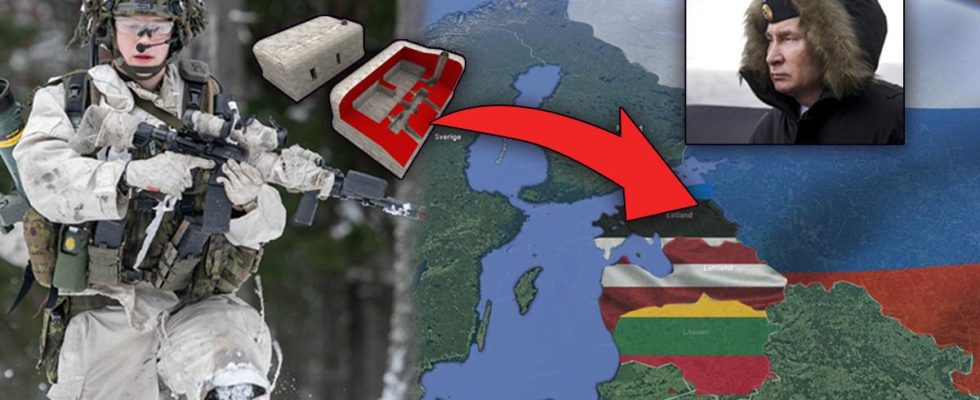Updated 00.42 | Published 00.11
unsaveSave
A network of underground bunkers will be the first line of defense to the east.
The NATO countries in the Baltics are now preparing to be ready if a Russian attack comes.
– We will attack the enemy from the first meter during the first hour, says the Estonian government.
Russia is now rearming at a pace which means that it would have the opportunity to attack NATO already within a few years.
This is now stated by the Danish Defense Minister Troels Lund Poulsen.
– This was not NATO’s assessment in 2023. This is new information that has only become known now, he says to Jyllands-Posten.
– Russia’s capacity to produce military equipment has increased tremendously.
expand-left
full screen President Putin in the much talked about interview with American media profiler Tucker Carlson last week. Photo: Gavriil Grigorov, Sputnik/Kremlin Pool Photo Via AP
Putin, for his part, says he has “no interest” in invading more neighbors.
In the high-profile interview with Tucker Carlson, the Russian president was asked if he sees a scenario where he would send troops into Poland.
– There is only one such scenario. If Poland attacks Russia. Why? Because we have no interest in Poland. Latvia or any other country. Why would we do that? We simply have no interest in it, Putin said.
Builds network of bunkers
But in the Baltics you don’t dare to take chances.
The defense ministers of Latvia, Lithuania and Estonia decided earlier this year to cooperate on a huge network of fortifications.
It is hoped that these will be able to deter Putin from seeing the countries as the next escalation of the war.
expand-left
full screenEstonian military exercises together with British soldiers in Lasna, Estonia. Archive image. Photo: Paulius Peleckis/Getty Images
Estonia’s government has now revealed more about plans to strengthen the defense of its eastern border – 33 miles of which is shared with neighboring Russia.
About 600 bunkers are part of the fortifications and are to be grouped around the border crossings in Narva in northeastern Estonia and Võru in the southeastern part.
The lake is a barrier
In between, it is believed that Lake Peipus, Europe’s fifth largest lake, will provide a powerful barrier between the countries.
expand-left
fullscreenLake Peipus, on the border between Estonia and Russia.
The idea is that Estonia should not have to end up on the defensive after a possible invasion across the border.
– The war in Ukraine has shown that it is extremely difficult and comes at a high price in human life, time and resources to take back occupied territory, says Susan Lilleväli at the Estonian Ministry of Defense during a press meeting about the plans, writes Newsweek.
– In addition to materiel, ammunition and manpower, we need physical installations to defend our countries effectively.
The Baltics have been seen as the likely starting point should Russia decide to attack NATO, although northern Finland has also been singled out as a possible site for a first strike.
Focus on the strip of land
In the previous NATO strategy, it was warned that Estonia “would have time to be destroyed” before the rest of the alliance came to the rescue. Now the tactic is that Russia should not be able to get through the front door.
– These installations must primarily have the purpose of avoiding military conflict in our region, as they can change the enemy’s calculations, says Susan Lilleväli.
– They must deny the enemy the opportunity to advance quickly into the Baltics and if a military incursion occurs, the enemy’s advance must be stopped already at the border.
She states that coordination with Latvia and Lithuania is required to “close all loopholes, as the security situation in the region shows no signs of improving”.
expand-left
full screen During the giant exercise Aurora 23 last year, both the military and the civil defense capabilities were tested in Sweden. Photo: Andreas Bardell
On the Lithuanian side, the focus should be mainly on the Suwałki Corridor, the narrow strip of land between the Russian exclave of Kaliningrad and Belarus, which would cut off the Baltics from Poland and allies in the west if occupied.
“Beat from the first meter”
– We must be ready to attack the enemy from the first meter and during the first hour, says Lilleväli.
The bunkers, which will begin to be ready in 2025, are described as “underground cellars” where ten soldiers with full equipment will be able to stay for a longer period of time.
The fortifications must be linked together with, among other things, electronic sensors.
– The lesson we learned is that we must find ways to stop, above all, advances by Russian troops. If we let them continue, it may soon be too late to protect all countries. Therefore, it must be started right from the beginning, at our borders, says Kaido Tiitus, lieutenant colonel and adviser to the Estonian government, according to Newsweek.
expand-left
full screen Russia is accused of using hybrid warfare. In most of the Swedish Armed Forces’ scenarios, it is assumed that they would try to knock out railways, electricity supply and communications first. Photo: Graphics/Paul Wallander
